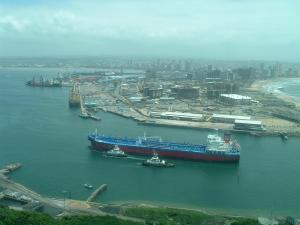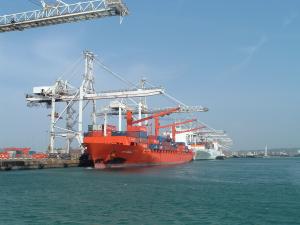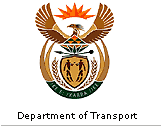 |
Port of DurbanThe port of Durban is situated on the east coast of South
Africa, some 680 nautical miles northwest of Cape Agulhas,
and 625 nautical miles south-south-west of the port of
Maputo. The GPS location is S 29.8689 and E 31.0617.
The port occupies the natural expanse of Durban Bay - an
area of 1850ha, with the water area being 892ha in extent
at high tide and 679ha at low. The emerging Point
waterfront development and central business district are
to the north and northeast, Maydon Wharf to the west, the
Bayhead ship repair area to the south, and the Bluff
Peninsula to the southeast.
The entrance channel is 122 metres wide and is maintained
at a dredged 12,8 metres draught (depth of water).
The entrance channel is protected by two breakwaters: the
northern is 335 metres and the southern 700 metres
long. Anchorages are allocated for vessels waiting to
enter port, about 1000 metres offshore to the north of
the mouth of the Umgeni River.
Port Limitations:The port of Durban operates 24 hours a day 365 days a
year. During daylight ships are supposedly restricted to
243.8m length with a maximum width of 35m and a draught of
11.9m, or 12.2m according to tide and harbour master's
clearance. Larger vessels are common, and ships up to 300m
lengths and 37m beams are regular callers in Durban. Night
restrictions are for a ship length of 200m, a beam of
26m, and maximum draught of 11.6m. The harbour master has
to be consulted for permission if larger vessels are to
enter port.

Ship entering Port of Durban
|
The largest ships to have entered Durban harbour were in
the region of 230,000 dwt, but even larger vessels are
catered for in the outer anchorage. On two occasions in
recent years the largest vessel afloat - the 564,650-dwt
ULCC tanker Jahre Viking which has a length of 458m and a
beam of 69m -underwent repairs or survey while at anchor
off Durban.
Pilotage is compulsory for all vessels from a point three
n.miles northeast of the port entrance, with a helicopter
performing most pilot transfers, backed up by pilot boat
when the helicopter is unavailable. Navigation (including
all shipping movements inside port limits) is subject to
VTS (vessels tracking service system) controlled from the
Millennium Tower on the Bluff. Tug assistance is required.
Draught within the port varies according to location.
Through the Ports Master Plan (PMP), the Transnet National
Ports Authority (NPA) has identified several new projects
for the port of Durban. This includes the widening and
deepening of the Durban harbour mouth to enable safer
access and access to larger ships at a cost of R1,7-
billion. The width of the channel will be increased to 220
m at its narrowest point, flaring into 300 m beyond the
south breakwater. The depth will vary from 19 m in the
outer channel to 18 m in the inner channel, and 16 m in
the inner port channels and basins. Work on this project
is
expected to be completed by the end of
2009.
In order to do this the base of the breakwaters has to be
excavated and repacked, and the main sewage outfall for
Durban has to be rebuilt at the required depth.
In the redevelopment of the port of Durban, the north
shore of the harbour and the adjacent land (including the
Point, Yacht Basin and Embankment areas) will continue
to be reserved for leisure and tourism developments. DocumentationDocuments required on arrival:-
Crew Lists, Passenger Lists (if applicable), Stowaway
Lists (if applicable), completed Customs Form (DA5), Crew
Declaration of Personal Effects, Narcotics List, Firearm
List (if applicable), Vaccination List, Maritime
Declaration of Health, valid De-Rat Certificate, valid
Loadline Certificates, Safety Radio Certificate, Safety
Equipment Certificate and ISM Certificates. Marine Craft:
The port operates a fleet of tugs owned and operated
by
the Transnet National Ports Authority (TNPA). Six of these
are
Schottel-type with bollard pull between 34t and 41t -
Umzumbe (ex Otto Buhr), Umsunduzi (ex Dupel Erasmus),
Umvoti (ex Bertie Groenewald), Nonoti (ex Jannie
Oelofsen), Inyalazi (ex Piet Aucamp), and Umhlali (ex Bart
Grove). Later-type tugs of a new series of Voith Schneider
49t bollard pull, and built at SA Shipyards in Durban,
began to be introduced from 2001. The two stationed at
Durban are named uThukela and Mkhuze.
Each tug is maintained to SAMSA class 8 standard, and
is
equipped for fire fighting and salvage. The fleet handles
in excess of 800 ship movements each month, and four tugs
are usually on duty during daylight hours and two at
night. The port also employs one work boat/tug of the Tern
class, Royal Tern, which has a bollard pull of 18.7 tons.
An Agusta A109 K2 'HPS' twin-engine 8-seat helicopter,
operated by Balmoral Maintenance Services, provides
pilotage services. A diesel-powered pilot boat named
Tsitsikama operates when the helicopter service is
unavailable.
Dredging is performed by Transnet National
Ports Authority
on an ongoing basis in the port and immediately outside
the entrance. The reason for this is to counter the
littoral drift that would otherwise recreate the infamous
Bar across the entrance channel. The major work is
conducted by a trailing suction hopper dredger named Piper
(ex RE Jones), with the dredged sand deposited into a
reclamation point on the northern breakwater, from where
it is dispersed by the municipality along Durban's
northern beaches. Piper loads 2,500 cubic metres at a time.
Other dredgers include the bed leveller named Impisi
(ex
LL Varley), which operates by dragging a plough across the
seabed to move accumulated silt against the wharfside into
the adjacent channel. The channels are kept clear with the
grab dredger, Crane (ex JF Craig), which uses a grab
attached to a crane on the vessel. Crane and Piper also
operate at East London and Port Elizabeth.Hydrographic
survey vessels used at the Port of Durban are the Ingwegwe
and the Swift.
Durban has two floating cranes. Indlovu has a lifting
capacity of 235 tons at 10m and 125 tons from 24m. The
smaller Imvubu is privately owned and has a lifting
capacity of 60 tons at 6.1m or 40.6 tons at 16.2m from the
outboard edge.
The port employs a number of launches and cargo punts,
including a 100+ passenger harbour boat named Isiponono
which is used for trade and business tours of the port. A
pollution boat named Udonti also serves the port. Several
private companies provide commercial diving services, and
the port also maintains a fully equipped diving team.
The NSRI, which has moved into a modern station base
at
the Point, operates several deep-sea and smaller rescue
craft. Port Facilities:The port of Durban operates on a common user basis and
consists of five business units managed by Transnet Port
Terminals - Durban Container Terminal (Africa's busiest),
Pier 1 Container Terminal, Multi-Purpose Terminal (also
known as the City Terminal), Durban Car Terminal (three
berths), and Maydon Wharf Terminal.
Container Terminal
Almost all containers are handled at DCT which is the
largest of its kind in the southern hemisphere. Containers
handled at the terminal currently represent more than 60%
of the total number handled at all South African ports.
DCT serves as a pivotal hub for the entire Southern
African region, serving trade links to the Far East,
Middle East, Australasia, South America, North America and
Europe. It also serves as a transhipment hub for East
Africa and Indian Ocean islands.
• The terminal has 2,128m of quayside divided into
seven berths, in addition to the use of three berths on
Pier 1 (part of the existing MPT). DCT has more than
13,000 ground slots and 600 reefer points, and handles an
average of 50 000 TEUs per month. A rail terminal receives
and dispatches containers to Johannesburg and other
destinations as far afield as Zambia. DCT is also
expanding its capacity from 1,9 million TEUs to 2,9
million TEUs per annum by 2009.
A Ro-Ro terminal, mainly serving the coastal
trade, is attached to the main container complex. A shed
is available with an undercover storage area of 8 380
square metres.
Total area (including Container Depot) 102.00 ha
Actual container/Ro-Ro stacking area 26.33 ha
Multi-Purpose Terminal
The new MPT facilities at the Point incorporates a
modern
intermodal cargo exchange terminal, a bonded storage
facility, and expanded cargo and container stacking areas
covering about 20 hectares.
The multi-purpose terminal, which handles break-bulk, bulk
and containerised cargoes, has become this port's largest
general cargo-handling facility. It operates across 14
berths at Pier 1, the Point and on the T-Jetty, and
handles both import and export breakbulk cargo. Pier 1 has
implemented container cranes and new container handling
systems (RTGs) to increase capacity to 700,000 TEUs per
annum by December 2007. Products handled at Durban MPT
include steel, ferro-alloys, granite, rice, fruit and
containers.

Durban Container Terminal
|
Durban Car Terminal
The Durban Car Terminal - the country's largest import
and
export facility for the motor industry - handled 386,062
motor units during the fiscal year 2005/06 (278,000 for
2005/06 and 214,000 for 2004/05). In 2006, 389681 units
were handled in the terminal, which represents a 41% on
the previous year’s volume. In 2007 this is expected
to
grow by 18%.
The Maydon Wharf MPT
This terminal operates across a number of berths at
Maydon
Wharf, principally between berths 8 to 13, and handles a
variety of commodities, focusing on niche cargo including
neo-bulks (salt, fertilisers and other mineral products,
steel, scrap metal and forest products).
The port has a well-equipped passenger terminal at N-
berth on the T-Jetty for the convenience of cruise ships,
which operate mostly between November and May. From the
summer of 2007 MSC and Starlight will maintain a cruise
ship for all-summer cruising at Durban, operating to
Indian Ocean island destinations. Cruise ships make use of
one or more berths as required and, at times, the port can
have as many as three cruise ships in port together. An
attractive Harbour Expo Market is mounted in the
airconditioned N-Shed while cruise ships are in port. Long-
term plans foresee a new cruise terminal being built at A
berth on the Point, near the Point Waterfront. Port Terminal Capacity and Throughput
Privately Owned Bulk-Storage and Handling Facilities
GROUND STORAGE FACILITIESConcrete storage bins of 18 290 ton capacity are located
at Causeway Road. Greystones EnterprisesContainer Freight Station, New Pier. This facility
performs all functions of container stuffing and de-
stuffing with bulk or unitised cargoes. Unitising of
cargoes, including bagging and palletising, are also
available. Facility is serviced with both road and rail
siding accesses. Berths and Layout

Aerial view of Durban Port
|
The port has two floating docks - one operated by the TNPA
with an overall length of 109m, a width of 23.34m and a
displaced lifting capacity of 4,500 tons, serviced by two
5-ton capacity cranes. The second floating dock, known as
Eldock, is the only privately owned one in South
Africa.
Eldock has a length of 155m, a width of 23.5m, and a
lifting capacity of 8,500 tons.
Bayhead has two general repair quays in addition to
several privately operated and fully equipped repair quays.
Bunkers: The port offers bunker facilities as
follows:
Fuel and gas oil at Island View, New Pier 1 and Pier 2
(container terminal) berths. Gas oil at Island View berths
4,5,6,7 and 8. Two bunkering companies - Smit Amandla and
KZN Bunkering - provide bunker barging services, but no
bunkers are served outside the port.
There is an anchorage outside the port for vessels waiting
for berthing or for orders. Yachting MarinasDurban has three marinas for yachting purposes - the main
marina opposite the Esplanade (served by the Point Yacht
Club and Royal Natal Yacht Club), the Wilson's Wharf
marina (used predominantly by motor craft), and the Bluff
Yacht Club facility in the Silt Canal near Bayhead. A new
marina is envisaged for the area immediately outside the
harbour entrance but remains subject to an environmental
impact assessment and other regulatory matters.
The port and city authorities also propose a combined
marina development in the area between Wilson's Wharf and
the Tug Basin (Bat Centre), which would be developed as a
waterfront. A large number of other recreational
activities take place in Durban Bay, including rowing,
canoeing and kayaking, parasailing, fishing from boats,
and bird watching at the Heritage Site (mangrove swamps). Port VolumesThe port of Durban handles the largest volume of sea-going
traffic of any port in southern Africa. For the 2006/07
financial year ended 31 March 2007, the Port of Durban
handled a total of 4,545 sea-going ships with a gross
tonnage of 97,453,430, or about 32 percent of the ships
calling at all South African ports. Details of Total Cargo Handled in 2006/2007.
Cargo handled during the fiscal year 2006/2007
amounted
to
41,483,950 tons, which included oil and petroleum products
but excluded containers, which are calculated by the port
authority in TEUs only and not by mass. A total of 2,335
million TEUs were handled in Durban during 2006/2007, and
may be calculated as the equivalent of 26,406,000 tons (av
13.5 tons) which should be included with the gross figure
above, giving the port a total volume of 73,006 million
tons of cargo handled.
Total volumes handled by the port (including the
calculation for containers) constituted 43,231,702 tons of
imports, 22,397,568 tons of exports and 7,377,166 tons of
transhipment cargo, giving a total of 73,074,436 tons.
Bulk cargo handled at the port in 2006/2007 was
33,719,039
tons, of which imports were 26,913,731 tons, exports
6,678,956 tons, and transhipments 126,352 tons.
Breakbulk cargo totalled 7,764,911 tons, of which
imports
were 4,355,419 tons, exports 3,173,400 tons, and
transhipments 236,092 tons.
Details of Container Movements in 2006/2007.
The combined Durban container terminals handled
2,334,999
TEUs (twenty foot equivalents) during 2006/2007, of which
imports were 865,087, exports were 899,454 and 519,609
were transhipped. A total of 50,849 TEUs were shipped
coastwise. Containers handled at Durban represented 65%
of the total number of containers at South African ports.
|
 |



